Mexican Omelette
Omelette...But Mexican

What Is Mexican Omelette?
A Mexican omelet is a type of omelet that incorporates traditional Mexican ingredients and flavors. It typically includes beaten eggs, diced tomatoes, onions, jalapeños, and shredded cheese, as well as other ingredients like black beans, avocado, cilantro, and salsa. Some variations may also include chorizo, a spicy sausage commonly used in Mexican cuisine. The ingredients are usually sautéed together before being folded into the omelet. Mexican omelets are often served for breakfast or brunch and are a flavorful way to start the day.
Ingredients For Mexican Omelette
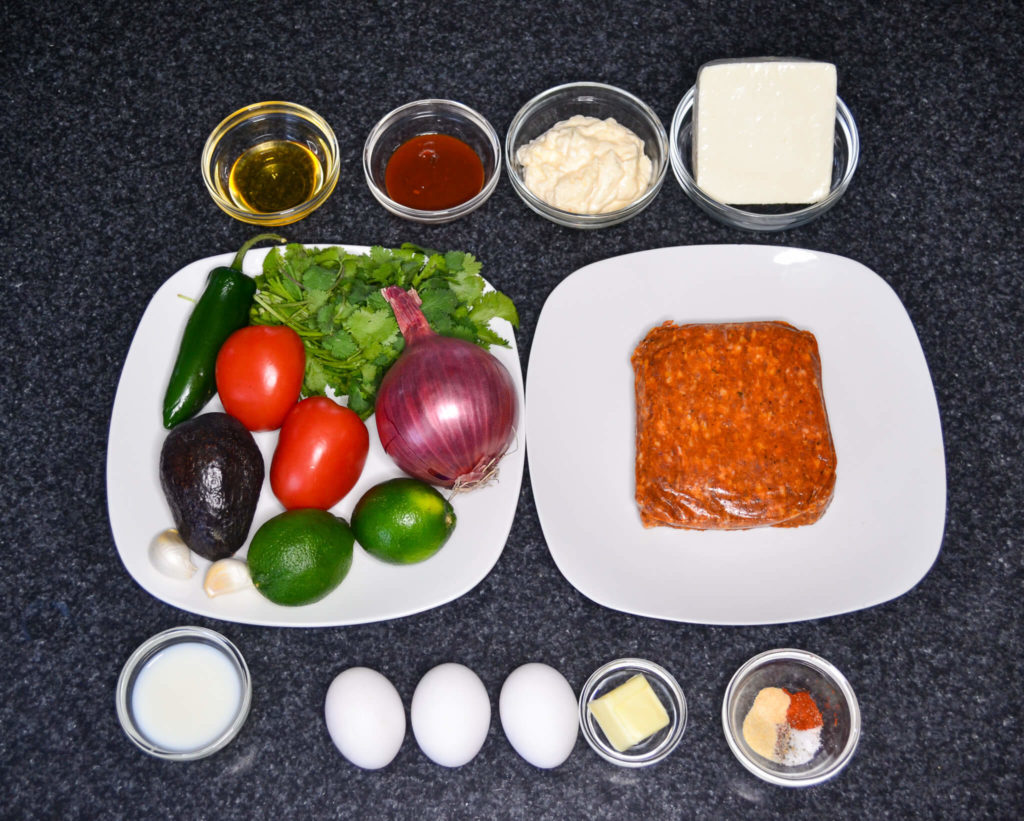

Produce
1 Avocado
1 Red Onion
1 Jalapeno
2 Tomatoes
2 Limes
Cilantro
Refrigerated
2 tsp Milk
2 tbsp Butter
3 Eggs
Queso Blanco Cheese

Grocery
2 tsp Honey
2 tbsp Adobo Chili
1/2 Cup of Mayonaise

Meat
1 lb Chorizo

Spices
1 tsp Salt
1 tsp Pepper
1 tsp Onion Powder
1 tsp Garlic Powder
1 tsp Paprika
How To Make Mexican Omelette
Step 1
Cook Your Meat

On medium high heat, add the ground chorizo to the skillet and cook for roughly 8-10 minutes.
If you aren’t familiar with chorizo, it’s a type of sausage that originated in Spain and is now a popular ingredient in many different types of cuisines around the world, particularly in Latin American and Mexican cuisine. The sausage is typically made from ground pork or beef, although there are also vegetarian and vegan versions made with plant-based ingredients.
The meat is usually seasoned with a variety of spices, including smoked paprika, garlic, and chili powder, which give it a distinctive spicy and smoky flavor. Other seasonings can include cumin, oregano, and coriander.
Chorizo can be found in both fresh and dried forms, and it can be used in a variety of dishes, including omelets, tacos, soups, stews, and sandwiches. In some countries, such as Mexico, it is often cooked with eggs and served for breakfast. In other places, such as Spain, it may be served as part of a tapas platter or used as a topping for pizza.
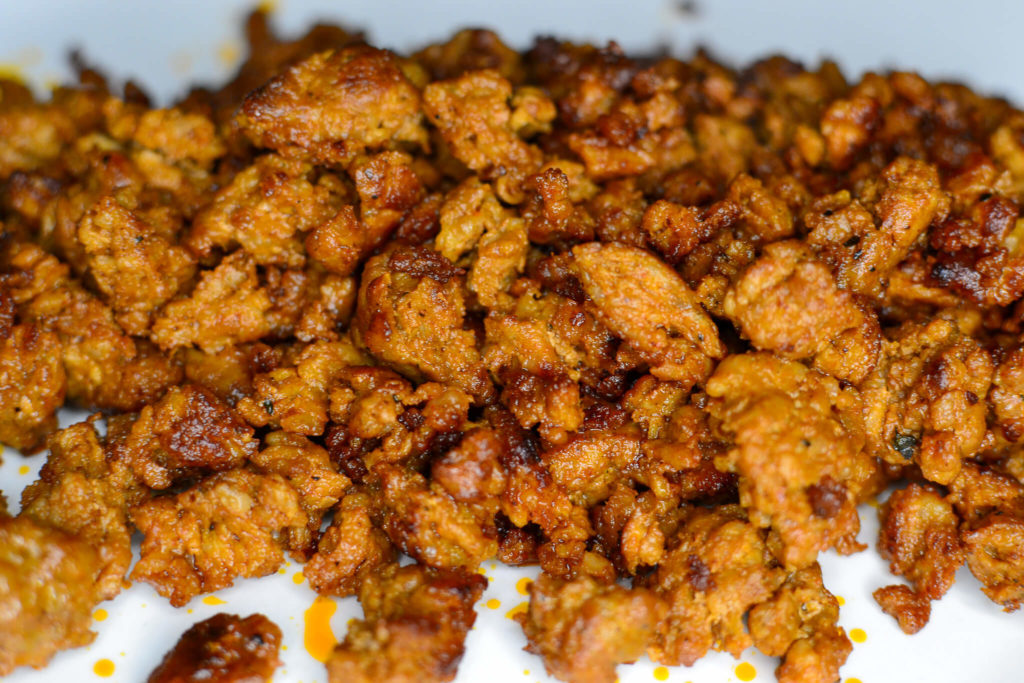
Once your chorizo has cooked through, set it aside.
Step 2
Prep & Cook Your Veggies
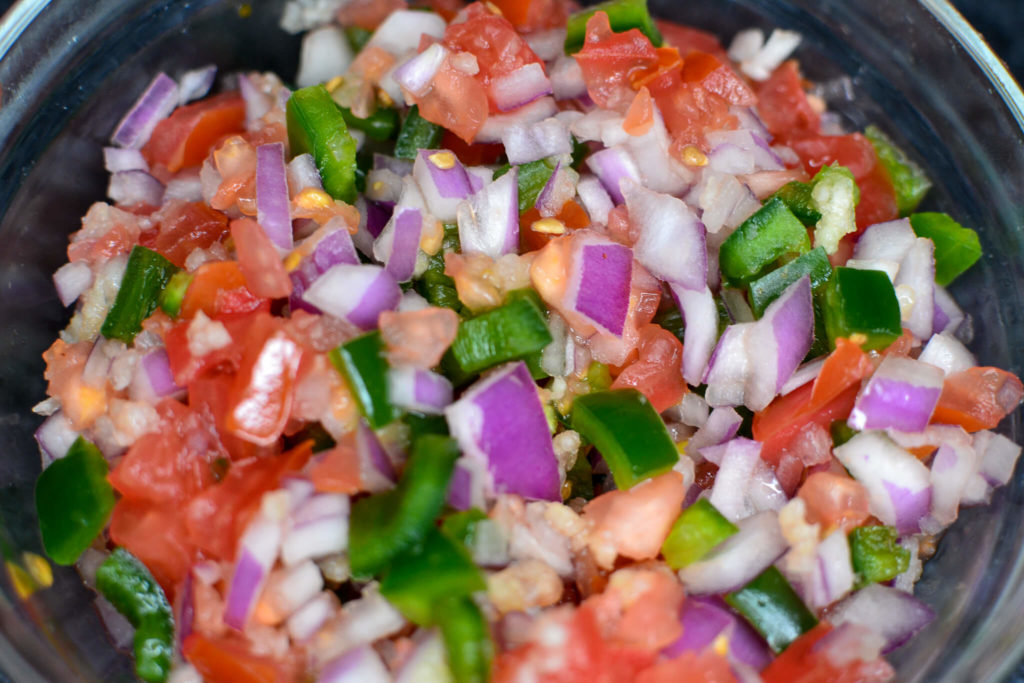
While the chorizo is cooking, you can begin dicing your:
- red onion
- tomatoes
- jalapeno
You can also mince your garlic, and combine them into one bowl. This is essentially a pico de gallo, but we aren’t adding the cilantro or fresh lime juice…yet.
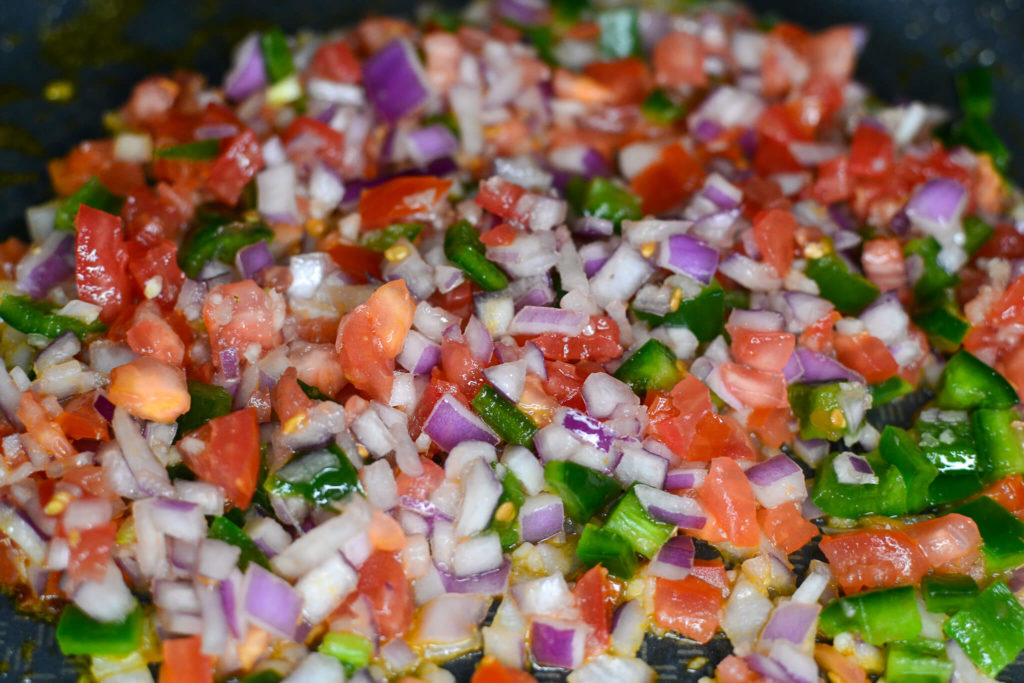
In the same skillet you cooked the chorizo in, add 1 tbsp of butter and a little olive oil, then add in your diced vegetables. Cook this down for about 3-5 minutes on medium heat.

Once you’ve cooked the vegetables, add them back into the bowl and add in your lime and cilantro.
Cilantro is a common ingredient in pico de gallo because it adds a fresh, bright flavor that complements the other ingredients. In addition to its flavor, cilantro also has some beneficial properties that can help improve the taste and nutritional value of pico de gallo.
One of the key benefits of cilantro is its ability to enhance the flavor of other ingredients. The herb contains a compound called linalool, which has a citrusy, floral scent that can help balance the acidity and spice of the other ingredients in pico de gallo.
Lime juice is a common ingredient in pico de gallo because it adds acidity and brightness to the dish. The acidic nature of lime juice helps to balance the other flavors in the pico de gallo, including the sweetness of the tomatoes and the heat of the peppers.
Step 3
Shred Cheese, Make Mayo & Egg Mixture
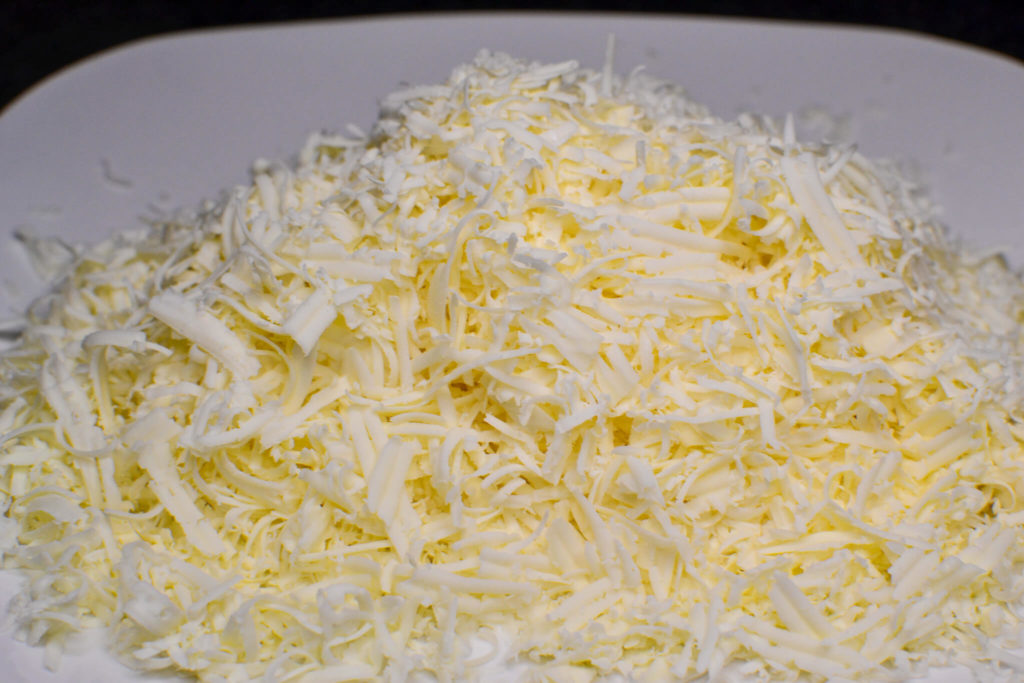
For this mexcan omelette recipe, we are choosing to use queso blanco for the cheese.
Queso blanco cheese is a type of soft, fresh cheese that originates from Latin America. It is commonly used in Mexican and Central American cuisine, as well as in other dishes throughout the region.
Queso blanco is made from cow’s milk and has a mild, slightly salty flavor. It has a crumbly texture and does not melt well, so it is typically used in dishes where it can be crumbled or cubed, such as in tacos, salads, and dips.
The cheese is typically made by curdling the milk with an acid, such as vinegar or lemon juice, and then heating and stirring the mixture until the curds form. The curds are then strained and pressed into molds to create the final cheese.

Once you’ve shredded your queso blanco cheese, it’s time to quickly make your chipotle mayo, which will serve as a great addition to the Mexican omelette.
Chipotle mayo is a creamy, spicy sauce made by combining mayonnaise with chipotle peppers in adobo sauce. Chipotle peppers are smoke-dried jalapeno peppers that have a distinctive smoky and spicy flavor, while adobo sauce is a tangy and slightly sweet sauce made with vinegar, garlic, and other seasonings.
To make chipotle mayo, the chipotle peppers are finely chopped or pureed and mixed with mayonnaise to create a smooth, creamy texture. Additional seasonings like lime juice, garlic, and salt may also be added to enhance the flavor.
For this recipe, grab a small bowl and combine:
- 1/2 cup of mayonnaise
- lime juice from 1 lime
- 2 tbsp of adobo chili sauce
- 2 tsp of honey
- 1 tsp of salt
- 1 tsp of pepper
- 1 tsp of garlic powder
- 1 tsp of onion powder
- 1 tsp of paprika
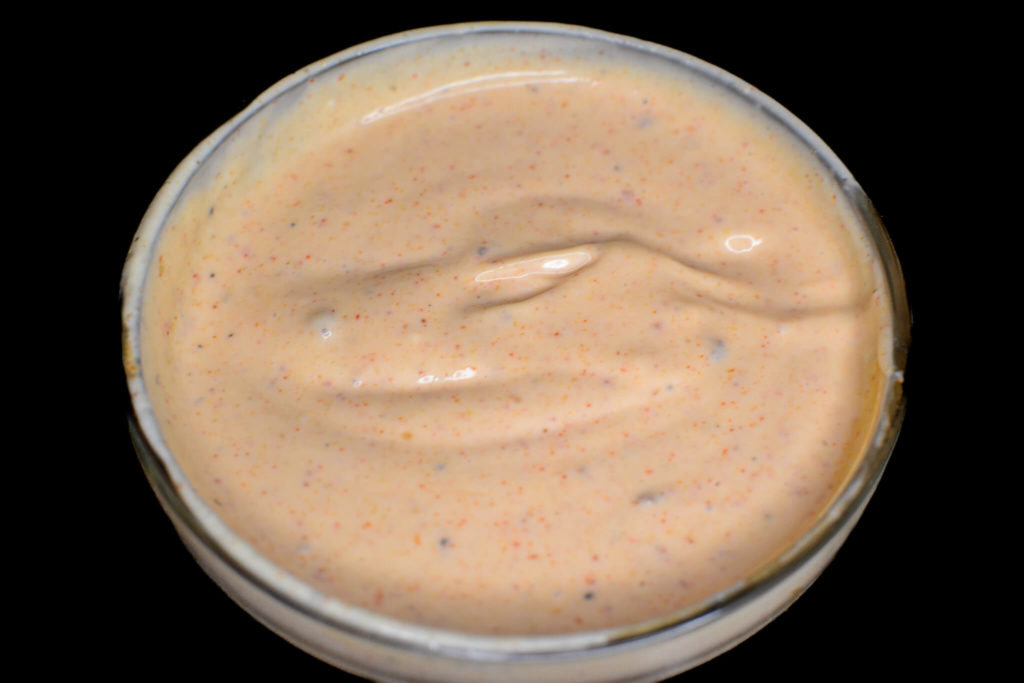
Once your chipotle mayo is stirred thoroughly it’s time to make the egg mixture.
In a small bowl, combine:
- 3 eggs
- 2 tsp milk
- 1 tsp pepper

Once you’ve added those three ingredients, you will need to whisk quite a bit.
Whisking is an important step when making an omelette because it helps to create a light, fluffy texture in the eggs. When eggs are whisked, air is incorporated into the mixture, which causes the eggs to expand and become light and airy when cooked.
Whisking the eggs thoroughly also helps to ensure that the yolks and whites are fully combined, creating a smooth and even consistency throughout the mixture. This helps to prevent the omelette from developing any tough or rubbery spots when cooked.
In addition, whisking the eggs before cooking can also help to create a more cohesive and evenly cooked omelette. By fully incorporating the eggs, the omelette will have a more consistent texture and will cook more evenly throughout.
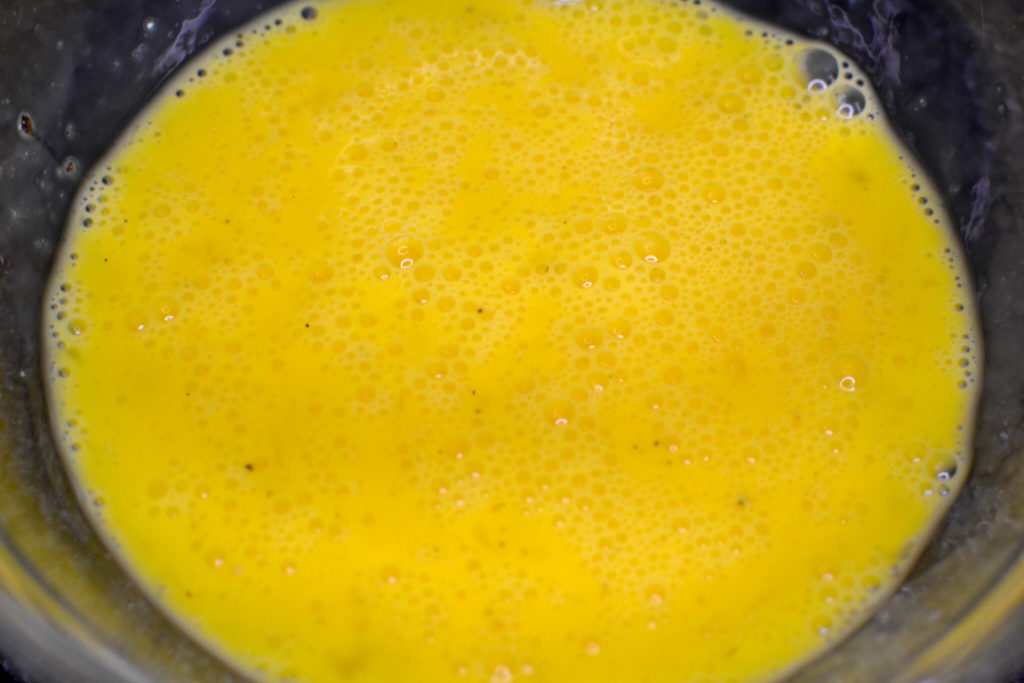
It is generally not necessary to let the egg mixture sit before cooking an omelette. In fact, it is best to cook the omelette immediately after whisking the eggs to prevent the mixture from separating or losing its light and airy texture.
If you need to prepare the egg mixture ahead of time, it is best to store it covered in the refrigerator until you are ready to cook it. However, it is important to note that the longer the mixture sits, the more it will lose its light and airy texture, which can result in a dense or tough omelette.
So, once this part is done, it’s time to cook the omelette.
Step 4
Cook Eggs & Assemble
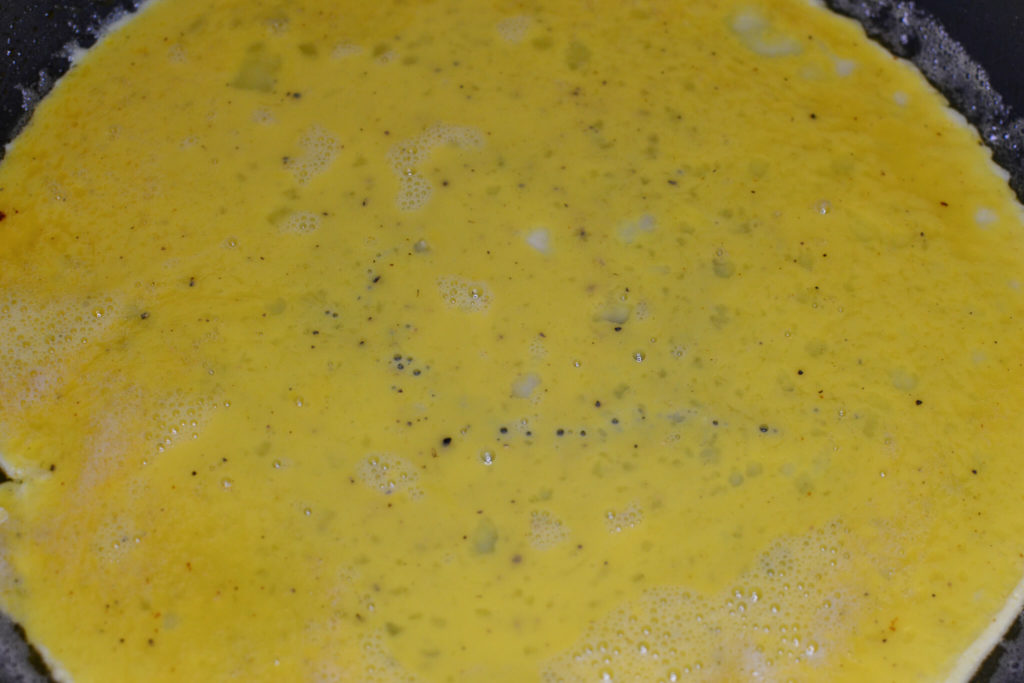
On medium-low heat, add 1 tbsp of butter to the skillet and let it melt. Then, add the egg mixture, allowing it to spread throughout the entire skillet.
When the omelette is almost fully set but still slightly runny on top, it is time to add the fillings.

Start by adding the queso blanco cheese, giving it the head start to melt into the egg mixture.
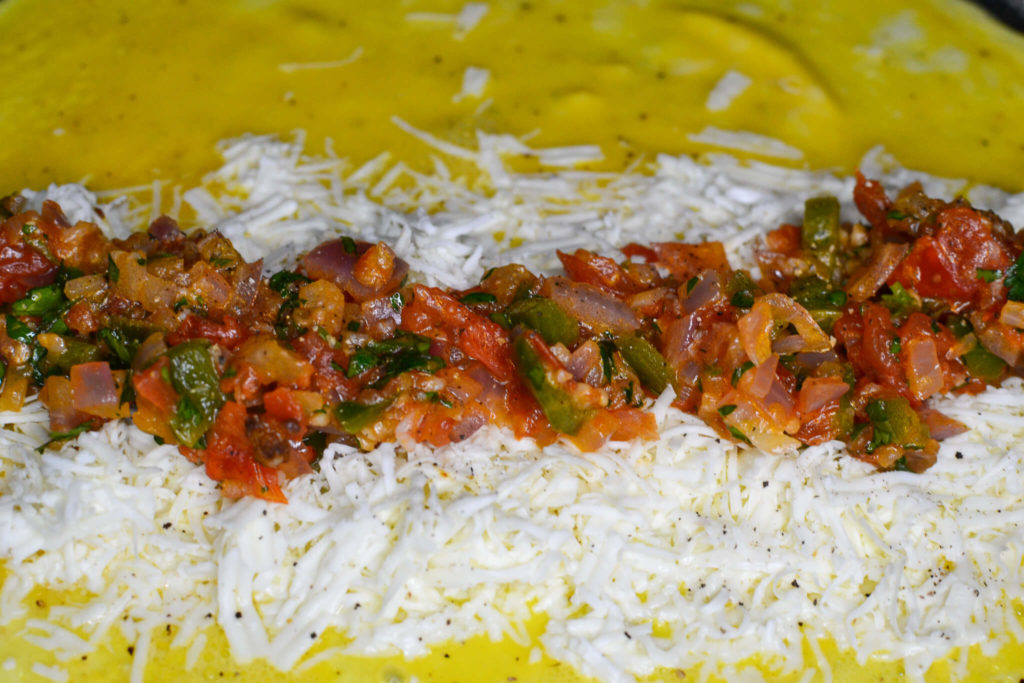
Then, add your vegetable mixture and season it with some pepper.
Seasoning vegetables with pepper can enhance their flavor by adding a mild to moderate level of spiciness and complexity to their taste. Pepper contains a compound called piperine that can stimulate the taste buds and create a mild heat sensation on the tongue.
In addition to its spicy flavor, pepper also has a slightly earthy and floral taste that can complement the natural flavors of many vegetables. This can help to bring out the sweetness, bitterness, or umami flavors of the vegetables, depending on the type of pepper and the vegetable being seasoned.
Pepper can also have a mild astringent effect on the tongue, which can help to balance the natural richness of some vegetables, such as roasted or sautéed root vegetables.

Lastly, add in your chorizo.
Cover the skillet and let it cook on low heat for another 2-3 minutes, which will allow the cheese to fully melt and the flavors to permeate throughout the omelette.

The hardest part of making an omelette is executing the fold. I lack some finesse, so there is a small hole in my fold, but if you cover it with cheese…nobody will notice, right?
After you’ve folded the egg in the middle, tilt the pan over the serving plate and gently slide the omelette onto the plate, with the folded edge on the bottom and the seam facing up.
Step 5
Garnish & Enjoy Your Mexican Omelette

Add some more of the shredded cheese to the top, along with some more vegetables if you’d like. Then, top it with some of that chipotle mayo, and add a side of avocado slices to pair with the omelette.
Enjoy!

Clickbait

Inspiration
Episode 7, The Son
“You know, your mother fell in love with me because of my three-egg omelet.” – Nick Brewer
More About Mexican Omelette

Mexican Omelette
Equipment
- 1 Skillet
- 1 Bowl
- 1 Whisk
- 1 Spatula
Ingredients
Produce
- 1 avocado
- 1 red onion
- 1 jalapeno
- cilantro chopped
- 2 limes
- 2 tomatoes
Refrigerated
- 2 tsp milk
- 2 tbsp butter
- 3 eggs
- Queso Blanco cheese
Grocery
- 2 tsp honey
- 2 tbsp adobo chili
- 1/2 cup mayonnaise
Meat
- 1 pound Chorizo
Spices
- 1/2 tsp salt
- 1/2 tsp black pepper
- 1 tsp onion powder
- 1 tsp garlic powder
- 1 tsp paprika
Instructions
Cook Your Meat
- Cook 1 lb of chorizo in a skillet over medium-high heat for 8-10 minutes. Set aside.
Prep & Cook Your Veggies
- Dice 1 red onion, 2 tomatoes, and 1 jalapeño. Mince garlic and combine.
- Sauté the diced vegetables in the same skillet with 1 tbsp of butter and a little olive oil for 3-5 minutes.
- Add lime juice and chopped cilantro to the cooked vegetables.
Shred Cheese, Make Mayo & Egg Mixture
- Shred queso blanco cheese.
- In a small bowl, mix 1/2 cup mayonnaise, juice from 1 lime, 2 tbsp adobo chili sauce, 2 tsp honey, 1 tsp salt, 1 tsp pepper, 1 tsp garlic powder, 1 tsp onion powder, and 1 tsp paprika to make chipotle mayo.
- In another bowl, whisk together 3 eggs, 2 tsp milk, and 1 tsp pepper.
Cook Eggs & Assemble
- On medium-low heat, add 1 tbsp butter to the skillet and pour in the egg mixture.
- When the omelette is almost set, add shredded queso blanco cheese, cooked vegetables, and chorizo.
- Fold the omelette and cook for 2-3 more minutes.
Garnish & Enjoy Your Mexican Omelette
- Top the omelette with extra shredded cheese, vegetables, and chipotle mayo. Serve with avocado slices on the side.
- Enjoy!

